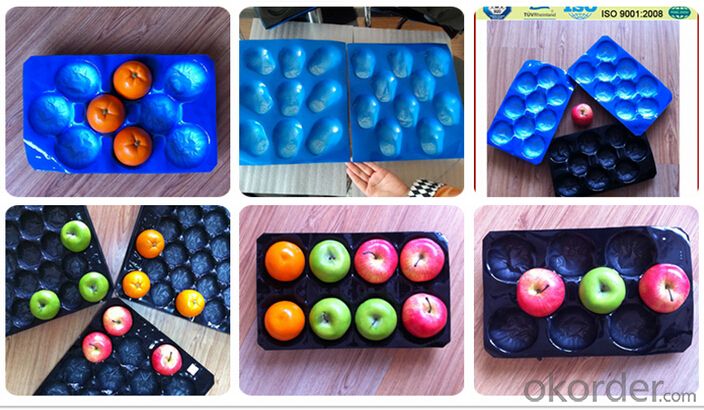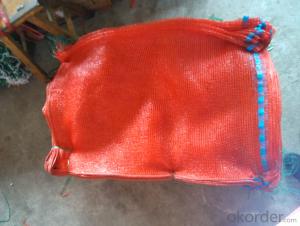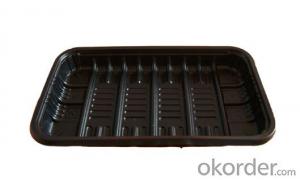Packaging PP Tray for Apple/Orange/Mango
- Loading Port:
- Qingdao
- Payment Terms:
- TT OR LC
- Min Order Qty:
- 100000 pc
- Supply Capability:
- 100000000 pc/month
OKorder Service Pledge
OKorder Financial Service
You Might Also Like
Introduction of Packaging PP Tray for Apple/Orange/Mango
1. made of PP , food class, eco-friendly
2.Size: 39*59cm 23*38cm
3.Weight:11g/pc,30g/pc
4.Color: black , red ,blue any color is available
5. Caliber: according to your requirement
6. wide range of sizes ,colors and formats
Application of Packaging PP Tray for Apple/Orange/Mango
1. Protection of your fruit from damage during transit,retail and display and preserve the quality of your fruit.
2. Maximum comfort during transport for fruit or vegetables.
3. Multiple perforations for maximum ventilation, Keep fruit orvegetables fresh.
4. Adaptable to all types of outer packaging
5. Can achieve good packing effect
6. To protect the fruit efficiently during its long journey to the international markets.
7. Packaging (with wood pallets)
Advantage of Packaging PP Tray for Apple/Orange/Mango
Designed to prevent rotation and contacts between fruits, GUOLIANG trays protect and promote your products.
The porosity and the controlled absorption of humidity allow better ventilation and ensure optimal conservation of goods during transport and their presentation in the distributor’s shelves.
Pictures of Packaging PP Tray for Apple/Orange/Mango



FAQ:
Q1 How fast can i get the quotation?
A We usually quote within 24 hours after we get your inquiry. If you are very urgent to get the price, please call us or tell us in your email so that we will regard your inquiry priority.
Q2 How can i get a sample to check your quality?
A After price confirmation, you can require for samples to check our quality.
Q3 What kind of files do you accept for?
A PDF, Word, Excel
Q4 Can you design for us?
A Yes. We have a professional team having rich experience in plastic tray design and manufacturing. Just tell us your ideas and we will help to carry out your ideas into perfect plastic tray. It does not matter if you do not have someone to complete files. Send us high resolution images, your Logo and text and tell us how you would like to arrange them. We will send you finished files for confirmation.
Q5 What about the lead time for mass production?
A Honestly, it depends on the order quantity and the season you place the order. we suggest that you start inquiry two months before the date you would like to get the products at your country.
- Q: Are agricultural plastic products resistant to chemicals used in farming?
- Yes, agricultural plastic products are designed to be resistant to the chemicals commonly used in farming. They are made from durable materials that can withstand exposure to various agricultural chemicals, ensuring their longevity and effectiveness in agricultural applications.
- Q: Can ground cover be used to create a cottage garden?
- Yes, ground cover can be used to create a cottage garden. Ground cover plants, such as creeping thyme, creeping phlox, or sweet alyssum, can add a charming and whimsical touch to a cottage garden. These low-growing plants can fill in gaps between other taller plants, cover bare ground, and create a carpet-like effect. They are often chosen for their ability to suppress weeds, retain moisture, and provide a lush and colorful ground layer. Overall, ground cover plants can enhance the overall aesthetic and functionality of a cottage garden.
- Q: hey can anybody body provide me with 5 or more resolutions to aviod plastic and products as far as possible.
- 1.canvas shopping bags instead of plastic ones 2.Get rid of your plastic dishes and cups, and replace them with glass varieties 3.Avoid products that are packaged in plastic 4.stainless steel water bottle instead of plastic bottles 5.stopped using plastic dish scrubbies to wash dishes. I now use Twist sponges, which are all natural and biodegradable. 6.)I stopped buying cream hand lotion, instead lotion that comes in a metal tin 7.)I return my styrofoam egg cartons
- Q: How does plastic windbreak netting help in protecting crops from wind damage?
- Plastic windbreak netting acts as a physical barrier that reduces the intensity of wind, thereby minimizing the risk of wind damage to crops. It creates a sheltered microclimate, which reduces wind speed, turbulence, and windborne debris, effectively safeguarding crops from potential harm caused by strong winds.
- Q: I read it from some food articles that now fast food moguls are putting plastic cheese into the foods, and take out the real cheese.What is that? and how to tell if it is plastic cheese or real cheese on my cooked pizza? Referrence photos would be great.
- It is cheese that feels like plastic
- Q: How do nursery trays help with plant propagation?
- Nursery trays provide a controlled and efficient environment for plant propagation by promoting the growth of healthy and uniform seedlings. They offer proper drainage, moisture retention, and aeration, which are essential for root development. Additionally, nursery trays make it easier to handle and transplant seedlings, improving their survival rate during the propagation process.
- Q: How does ground cover affect the pH of the soil?
- Ground cover can have a significant impact on the pH of the soil. Certain types of ground cover plants, such as mosses or acid-loving plants, can release organic acids that lower the pH of the soil, making it more acidic. On the other hand, other ground cover plants, like clovers or legumes, have the ability to fix nitrogen in the soil, which can increase the pH and make it more alkaline. Thus, the choice of ground cover can either raise or lower the pH of the soil depending on the specific plant species.
- Q: What are the potential health risks linked to the use of plastic mulch film in agriculture?
- <p>Yes, there are health hazards associated with the use of agricultural plastic mulch film. These include the potential release of harmful chemicals into the soil and water, which can contaminate crops and enter the food chain. Additionally, improper disposal of the plastic film can lead to environmental pollution and the ingestion of microplastics by humans and animals, posing risks to their health. It's important to use and dispose of plastic mulch films responsibly to minimize these risks.</p>
- Q: Can ground cover plants be used to improve soil aeration?
- Yes, ground cover plants can indeed be used to improve soil aeration. These plants help to loosen and break up compacted soil, allowing for better airflow and water penetration. Their root systems create channels in the soil, increasing porosity and reducing soil compaction. This, in turn, enhances the exchange of gases between the soil and the atmosphere, promoting healthier root growth and overall soil health.
- Q: Can nursery trays be used for orchid propagation?
- Yes, nursery trays can be used for orchid propagation. Nursery trays provide a convenient and organized method for propagating orchids, allowing for easy monitoring and care of the plants. The trays can accommodate multiple orchid seedlings or divisions, providing them with the necessary space to grow and develop. Additionally, the trays often have drainage holes, allowing for proper water management and preventing over-watering.
Send your message to us
Packaging PP Tray for Apple/Orange/Mango
- Loading Port:
- Qingdao
- Payment Terms:
- TT OR LC
- Min Order Qty:
- 100000 pc
- Supply Capability:
- 100000000 pc/month
OKorder Service Pledge
OKorder Financial Service
Similar products
Hot products
Hot Searches
Related keywords




























